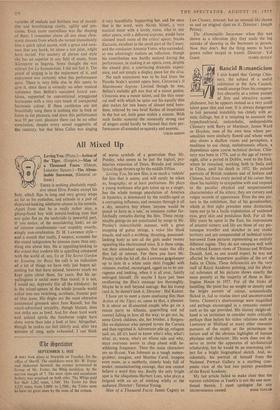Rancid Romanticism
I HAD hoped that George Chin- nery, the subject of a useful exhibition at the Arts Council, would emerge from his compara- tive obscurity as a minor painter of firm and attractive accom- plishment, but he appears instead as a very small talent gone thin and sour. It is always dangerous to link personal instability too closely with ar- tistic failings, but it is tempting to associate the hypochondriacal, melancholic, undependable Chinnery with Barry or Mortimer, James Ward or Haydon, men of his own time whose per- sonalities were similarly flawed and whose work also shows a shallow vision and perception, a readiness to use cheap, melodramatic effects, a dependence upon coarse technical devices. Chin- nery was born in 1774, and at the age of twenty- eight, after a period in Dublin, went to the East, where he remained, working both in India and in China, until his death in 1852. He painted portraits of British residents and of Indians and Chinese, but from every period of his career they show his inability to sympathise with and respond to the peculiar physical and temperamental characteristics of his sitters; they are cursory and vulgar records of appearance. Even the one pic- ture in the exhibition, that of his grandmother, which at first sight promises some distinction, turns out to be a facile exploitation of reddened eyes, grey skin and pendulous flesh. For all the fifty years he spent in the East, his impressions of oriental scenery and life are those of any pic- turesque traveller and sketcher in any exotic territory and are compounded of technical tricks borrowed from pictures representing an entirely different region. They do not compare well with the refined Eastern views of Thomas and William Daniell. And, as one would expect, he was not affected by the important qualities of the art of India or China. These deficiencies are the very stuff of Royal Academy painting, and the physi- cal substance of his pictures shows exactly the same poverty as the majority of those in Bur- lington House in 1957. For all the tricks of handling, the paint has no weight or density and the bright accents of colour, automatically flicked in, fail to vitalise inert and unconstructed forms. Chinnery's shortcomings were magnified and perhaps encouraged in a romantic context such as his age provided. His clumsy sleight-of- hand is an invitation to consider more critically perhaps than before his richer relations such as Lawrence or Morland or many other romantic
pursuers of the exotic or the picturesque in nature and of the obvious highlights of human physique and character. His work does not de- serve or invite the apparatus of art-historical scholarship, but he would be an interesting sub- ject for a bright biographical sketch. And, in- cidentally, his portrait of himself from the National Portrait Gallery is a startling com- posite view of the last two painter presidents of the Royal Academy.
My last article failed to make clear that the current exhibition at Tooth's is not the one men- tioned therein. I must apologise for any






























 Previous page
Previous page